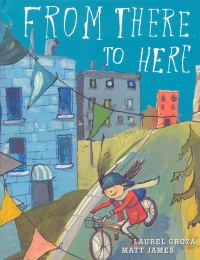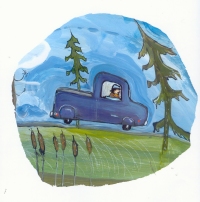| ________________
CM . . .
. Volume XX Number 25. . . .February 28, 2014
excerpt:
The young heroine of From There to Here has just moved. She loved her wilderness home in northern Saskatchewan where her father was helping to build a dam to provide electricity for the prairies. The family has moved to Toronto because her father is helping to build a highway in Toronto. She misses living in a place “carved into the middle of the bush.” It is not until her neighbour, Anne, invites her out for a bike ride that the young heroine of this picture book starts to smile. She realizes that “It was different there. Not the same as here.”
The wonderful illustrations of Matt James show our heroine coming to terms with her new home in Toronto. On each page, the colour red provides a unifying element since the heroine wears red throughout. Several other objects also pick up this element – the red truck, the stop sign, the aurora borealis, Anne’s red bicycle, and the “red star” which symbolizes Toronto on the map in the endpapers. Readers should definitely notice the marvellous endpapers which provide a map of the journey from the Prairies to Toronto with lots of interesting geographical information about Canada. The vocabulary of this picture book is simple and easy to understand. The narrator frequently speaks in phrases rather than sentences, i.e. “There.” “No fences.” “Or front yards.” The writer’s purpose in using this technique is to reflect the young heroine’s inner thoughts as she sorts through the realities of her new environment. In a classroom setting, this picture book could also be a great tool for engaging students in discussions about Canadian geography, urban environment, nature, adapting to change, making friends and descriptive writing. Highly Recommended. Myra Junyk, a literacy advocate and author, lives in Toronto, ON.
To comment
on this title or this review, send mail to cm@umanitoba.ca.
Copyright © the Manitoba Library Association. Reproduction for personal
use is permitted only if this copyright notice is maintained. Any
other reproduction is prohibited without permission.
NEXT REVIEW |
TABLE OF CONTENTS FOR THIS ISSUE
- February 28, 2014.
AUTHORS |
TITLES |
MEDIA REVIEWS |
PROFILES |
BACK ISSUES |
SEARCH |
CMARCHIVE |
HOME |

 From There to Here is the much anticipated sequel to
From There to Here is the much anticipated sequel to